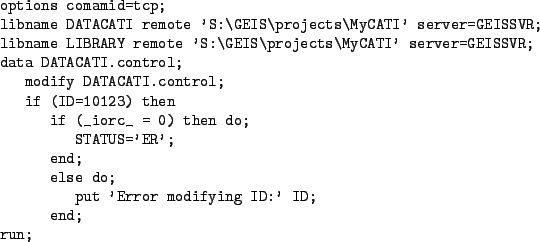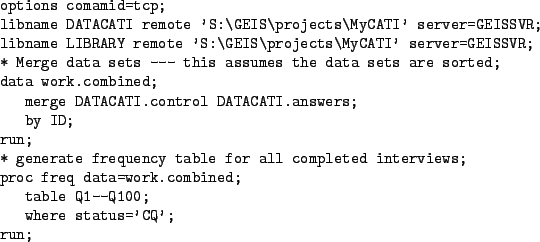Formats are used to convert numeric answer codes to textual responses. The user may also define his or her own formats and save them to the file \GEIS\BIN\FORMATS.SASin the user's project directory. To use the formats, the format names must be specified within the script item's definitions.
If the user definitions are used, click Develop, then Utilities, and then Make Formats. This processes the files and saves the formats to FORMATS.SC2. This is also done automatically by the compiler.
User formats are optional since GEIS can generate formats automatically.
This occurs if the items specify the _MAKE_ option in the script.
The compiler saves automatically-generated format definitions to
the file
FMTFILE.SAS in the user's project directory.
Refer to \GEIS\BIN\GEIS.TXT for details on the _MAKE_ option.
GEIS also uses its own formats, which are called the system formats.
These are defined in the \GEIS\BIN\FORMATS.SASfile.
There is rarely any need to edit these formats.
Altering them may affect GEIS's operation.
Once a survey is complete, the data from the ANSWERS and CONTROL data sets may be combined into a single data set, called FINAL. This allows statistical analyses to make use of the interview control information in CONTROL.
The process also splits up any MULT items22character strings into a series of variables. Each variable generated corresponds to a single option in the original MULT item.
Apart from ANSWERS and CONTROL, additional information for analysis may be obtained from the CALLS and ILOG data sets.
After the survey is complete,
the CONFID data set may be deleted or removed to a secure location.
This eliminates any connection of the respondent contact information with the responses.
To further protect respondent confidentiality,
back-ups of the CONFID data set should also be removed.
It should be noted that the ILOG data set may also
contain respondent's names.
Due to the variety and complexity of reports that may be needed no detailed reports are included in GEIS. Instead, the advice of a statistician should sought and software written to generate the reports. Examples of both methods are shown below.
An example of a maintenance program that may be run whilst interviewing is in progress is shown in Figure 24. This program modifies the STATUS variable in CONTROL. Note that this particular action can also be done directly by using the GEIS Control Panel, but a programmatic approach provides a greater flexibility. The program firstly defines the communications protocol, in this case: TCP. Then it assigns libnames by referencing the share server, GEISSVR. Finally it modifies the STATUS variable in CONTROL. To do this it attempts to lock the record with ID=10123 and if it succeeds it changes the value of the STATUS variable. If it does not succeed it prints an error message. This could mean that the respondent is currently being interviewed, but there are other possibilities, such as another program that has locked the record or data set.
Another example is shown in Figure 25. This summarises the frequencies of the status codes in the STATUS variable. This program can be run when interviewing is on-going. There is no risk of interfering with the data collection since the data set is only read and not modified.

